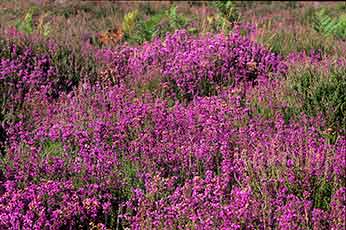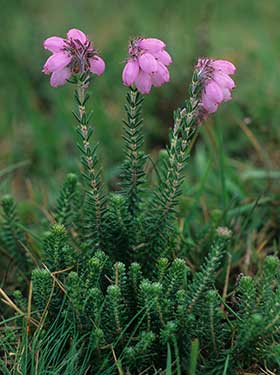Bell heather
Cross-leaved heath
Heather
(Erica cinerea, Erica tetralix and Calluna vulgaris)
When: All the year round
How many: Very widespread and very often abundant

Few can fail to be impressed by sight of the New Forest heathlands in mid to late-summer as the land glows pink and purple, brought to life by the flowering of the heathers.
Heather, or ling, as it is sometimes known, is often the dominant plant on dry heaths, but two other closely related, species also occur: bell heather and cross-leaved heath, both of which are also common and widespread.
Heather is a tough, wiry, sprawling plant with much-branched, tangled stems. It can reach a height of 90 centimetres (36 inches), and live for up to 40 years. Plants grow tightly packed together and often form an almost impenetrable barrier to New Forest commoners’ stock and man.
Heather stems retain a year-round wine-red colour, whilst the loose spikes of small, delicate flowers appear in August and September, and are most often pale purple, with occasional ‘lucky’ white variants.
Bell heather and cross-leaved heath are typically shorter, less wiry, less bushy plants. Both bell heather and cross-leaved heath grow to a height of around 60 centimetres (24 inches), and tend to like a reasonable amount of space between themselves and their neighbours. Both can be found in flower from late-spring through to mid-autumn.

Bell heather favours dry ground, where its dark green foliage is beautifully offset by deeply coloured, robust, red-purple, bell-shaped blooms.
Cross-leaved heath, however, tends to grow in wetter places, and is sometimes known as bog heather. A somewhat downy, silvery grey-green plant, it too has quite large, globular flowers, but most often of a very pale pink colour. Slender leaves in groups of four form the tiny crosses that give the plant its common name.
Heather, bell heather and cross-leaved heath are all rich in nectar and pollen, attracting a wealth of insects, including bees that can often be seen buzzing from plant to plant, thighs weighed down by the summer’s harvest. The resulting honey is distinctively dark, delicious and with a delightful fragrance.

Young heather shoots form an important element in the diet of New Forest ponies and other stock animals, particularly during the winter months when grass is not readily available. As heather ages, though, it becomes less palatable, so relatively small sections of New Forest heathland are burnt on a controlled, rotational basis to remove the tough old heather stems and encourage regeneration of tasty young replacements.
Heather was once an important element in the rural economy. Indeed, heather's scientific name Calluna comes from the Greek word meaning ’to brush’, which is a reference to use for making sweeping brooms. Local names such as bazzom and bissom are also dialect forms of besom (or broom).
Other uses for heather included as an ingredient in home made tea, a flavouring for ale, to produce orange dye, for making baskets, as a thatching material and also for fuel for the fire. Whole heather plants were also used to fill mattresses which apparently made surprisingly comfortable, aromatic beds, whilst John Gerard, the 16th century herbalist, noted of heather that: ‘the tender tops and flowers were said to be good when laid upon the bitings and stingings of any venomous beast.’
References:
The Wild Flowers of Britain and Northern Europe: Richard Fitter, Alastair Fitter and Marjorie Blamey
The New Forest – A Natural History: Colin R. Tubbs
Reader’s Digest Field Guide to the Wild Flowers of Britain
The Earthwork Remains of Enclosure in the New Forest: Nicola Smith, Proceedings of the Hampshire Field Club and Archaeological Society, 1999.
The Englishman’s Flora: Geoffrey Grigson
The Herball or General Historie of Plantes: John Gerard
More links
Other related links
Search this site

Sadly, 58 animals were killed - 35 ponies, 13 cows, 8 donkeys and 2 sheep, whilst a further 32 were injured - 3 pigs, 9 donkeys, 11 cows and 9 ponies.
(Forty-three accidents occurred in daylight, 15 at twilight and 101 in the dark. Twenty-seven accidents were not reported by the driver involved).
Here's just one horrific example - Three donkeys killed in collision with van at notorious New Forest blackspot (Advertiser and Times)

